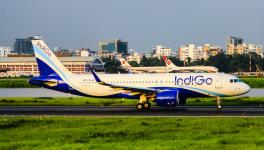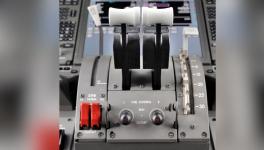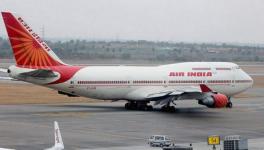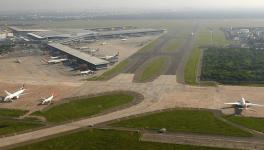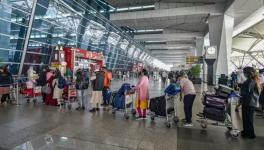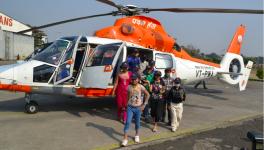Kozhikode Air Crash: ‘Pilot Error’ Narrative Can’t Hide Haunting Issues
Image for representational use only.Image Courtesy : The Indian Express
Air India Express ‘Vande Bharat’ Flight IX 1134 evacuating stranded Indians from Dubai to India, tragically crashed at Calicut International Airport in Karipur near Kozhikode in rainy conditions on August 7, 2020.
The 737 NG aircraft had overshot the tabletop runway, crashed through the boundary wall, tipped over the edge to drop over 35 feet, and broke into half, with the front portion bearing the brunt and seeing most of the deaths. At the time of writing, 18 persons including the pilot and co-pilot had died, and around 149 out of the total 190 passengers and crew with injuries of varying degrees were in 13 hospitals in Kozhikode and nearby towns.
The Air Accidents Investigation Board (AAIB), constituted in 2012, has started its study and the vital black box or Flight Data Recorder (FDR) and cockpit voice recorder (CVR) have been recovered intact. Union Minister for Civil Aviation, Hardeep Puri, and top officials of the Directorate General of Civil Aviation (DGCA) descended on Kozhikode once the runway had been cleared of debris.
The media has been full of speculation about possible causes of the crash and stories about inadequacies at Calicut Airport, some right and some wrong. One senior safety expert, the redoubtable Captain Mohan Ranganathan, part of the inquiry team into the 2010 crash at the tabletop Mangalore airport, even went so far as to proclaim that the Calicut air crash was “not an accident but an act of murder” by the airport authorities, DGCA and Civil Aviation Ministry, which had failed to implement the safety measures recommended after Mangalore.
Authorities Build ‘pilot error’ Narrative
Minister Puri shared some instant wisdom with the media in Kozhikode, while simultaneously appealing to all concerned not to speculate, but to await the results of the investigation. However, this has not stopped the minister himself, DGCA, and the Airports Authority of India (AAI), which runs Calicut International Airport, from selectively releasing information to the press.
The minister said all safety measures were in place and “we” would not have permitted the airport to operate otherwise. DGCA said all safety measures were in place, while AAI-Calicut reiterated this, while both repeatedly pointed to the pilots having aborted a first landing attempt and, on their second attempt, having touched down a good 1 km or more than 3,000 feet from the start of the runway, leaving little space to brake, especially under the rainy conditions.
Each agency was clearly covering its own backside, and all of them not so subtly building a narrative blaming the pilots who, unfortunately, cannot defend themselves. The FDR and CVR, along with downloaded data from Boeing, will undoubtedly reveal more about the crash and various factors contributing to it.
Whatever the immediate circumstances, several issues continue to haunt aviation safety in India, especially at tabletop airports, such as at Calicut, Mangalore, Shimla, Kullu, Lengpui (Mizoram) and Pakyong (Sikkim). It is necessary to highlight these so that the usual short-term responses are not repeated and long-term solutions emerge.
The Crash
First, the facts.
The Calicut Airport runway had been extended in 2017 to 2,450 metres (8,038 feet) to permit landing of wide-bodied aircraft, which had not been allowed since 2015. Boeing 777s and even 747 jumbo jets have landed safely there since then. The RESA (runway end safety areas) on both ends had been increased to 240m from the earlier 90m, shortening the runway by about 100m.
After DGCA sharply warned AAI-Calicut in 2017, runway friction was regularly monitored and a machine for removal of rubber residue from the runway was only recently acquired from Chennai. So, Calicut Airport and DGCA, which was to ensure implementation, had indeed acted on all the recommendations after the Mangalore crash, but only between 2017 and 2019, a good 6-8 years later. Only luck saw no crashes during this period.
The pilots had aborted the first attempt to land at Runway 28, having received information from Air Traffic Control (ATC) on visibility, rainfall and winds, indicating poor conditions they had noted at or before Decision Height of 200 ft. They then went around and attempted landing from the other side of the runway, designated Runway 10, known to be riskier with a downward slope, and with a tailwind to boot. What transpired inside the cockpit, between the pilots and ATC, and other pertinent information will be known from the FDR and CVR data.
Did ATC warn the aircraft about its excess height, perhaps speed too? Was the Category-I Instrument Landing System (ILS) at Runway 10 functioning properly? Was the safe landing zone clearly marked on the runway? Did the runway have centre lights, some experts having questioned that? How come the pilots did not initiate another go-around? Were the pilots fatigued and stressed, as noted by several pilots on Vande Bharat flights with their long flight-times without rest?
Whatever the reason, the aircraft seems to have landed well after the safe zone, touching down at over 1km distance. The aircraft then overshot the runway, unable to brake sufficiently due to the wet runway, and tipped over the edge of the table top.
Long-Term Solutions
The first and major question is, which agency exactly is responsible for the investigation, and can it be relied upon to be genuinely independent? AAIB was set up in 2012 after repeated calls by many, including this writer, and from international agencies, such as International Civil Aviation Organisation or ICAO, to move accident investigations out from DGCA due to the obvious clash of interests since DGCA is also the inspection and clearance agency.
Yet, AAIB too has been set up “under” the Civil Aviation Ministry, its website also gives information about ministry, and all statements about the crash, including when the investigation report may be expected, have been coming from DGCA or the ministry.
The problem remains that the Civil Aviation Ministry, DGCA, AAI, Air India and AAIB are all government agencies and there are chances of AAIB protecting the interests of all other government agencies.
Lack of autonomy of supposedly independent authorities has long been a reality in India. Under the present government, enforced dominance of the political executive has reached an extreme, and one can expect the Civil Aviation Ministry to fully control and drive the Kozhikode air crash investigation and its aftermath.
Responsibility for the crash is most likely to be laid at the pilots’ feet, with a few tangential observations, as in most air crash investigations in India. Measures to ensure full and complete autonomy of AAIB, including through statutory provisions, are a must.
Second, an important recommendation after the 2010 Mangalore crash was to provide Engineered Materials Arrestor Systems (EMAS) at both ends of the runway. EMAS are layers of crushable concrete and other materials, which absorb the aircraft energy after it overshoots, quickly slowing it down to a stop, with minimum damage to aircraft, passengers or cargo.
EMAS should ideally be around 120-180m.
EMAS are already in place in most military airports in India. These are mandatory in US airports, with the Federal Aviation Administration even paying for many of them, and ICAO is expected to soon release global advisories for the same.
It is learnt that AAI Calicut has so far declined to install EMAS due to high initial and maintenance costs. Detailed studies in the US and European Union have shown EMAS to have high cost-benefits when weighed against possible accidents. Should cost really be a factor when weighed against loss of life and aircraft? Expeditious action should be taken to install EMAS, at least at all tabletop runways in India.
The issue of additional runway length at Calicut Airport, as recommended and currently stuck due to resistance of local residents, should also be addressed by AAI with the assistance of the Kerala government. Sharing of costs between different Central and state agencies should be explored.
Third, another less-addressed problem in tabletop runways is that the terrain is such that vehicle movement is easy at the airport itself, but very poor below the table. In Karipur, too, while local people were the first to reach the crashed aircraft and start rescue work, limited airport fire tenders and rescue personnel came next, and local fire engines and others came to the spot much later. Access roads should be built quickly to enable fire and rescue teams to reach the airport periphery. Other emergency response measures should also be reviewed.
Fourth, DGCA should frame and issue new guidelines to ATCs and airlines regarding landing conditions at all tabletop runways in India during rainy conditions, along the lines of fog warnings. In the present instance, had such guidelines been in place, good alternative airports were available very close by at Kannur and Kochi, and the aircraft could have been diverted there.
Actual safety ought to be the guiding and deciding factor henceforth, not airport or airline viability, political pressure or protecting vested interests. It is hoped the AAIB will be up to the task and be truly independent guardians of civil aviation safety.
Get the latest reports & analysis with people's perspective on Protests, movements & deep analytical videos, discussions of the current affairs in your Telegram app. Subscribe to NewsClick's Telegram channel & get Real-Time updates on stories, as they get published on our website.









